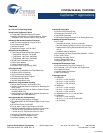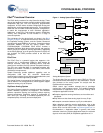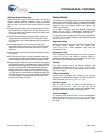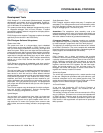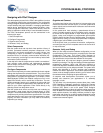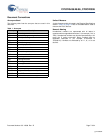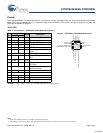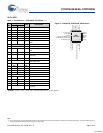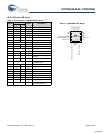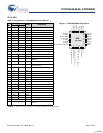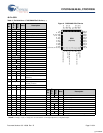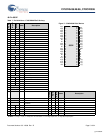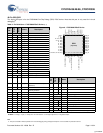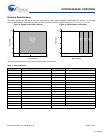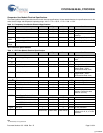
CY8C20x36/46/66, CY8C20396
Document Number: 001-12696 Rev. *D Page 4 of 34
Additional System Resources
System Resources, some of which are listed in the previous
sections, provide additional capability useful to complete
systems. Additional resources include low voltage detection and
power on reset. The merits of each system resource are listed
here:
■ The I2C slave/SPI master-slave module provides 50/100/400
kHz communication over two wires. SPI communication over
three or four wires runs at speeds of 46.9 kHz to 3 MHz (lower
for a slower system clock).
■ The I2C hardware address recognition feature reduces the
already low power consumption by eliminating the need for
CPU intervention until a packet addressed to the target device
is received.
■ Low Voltage Detection (LVD) interrupts can signal the
application of falling voltage levels, while the advanced POR
(Power-On-Reset) circuit eliminates the need for a system
supervisor.
■ An internal reference provides an absolute reference for capac-
itive sensing.
■ The 5.5V maximum input, 1.8/2.5/3V-selectable output, low-
dropout regulator (LDO) provides regulation for IOs. A register-
controlled bypass mode allows the user to disable the LDO.
■ Standard Cypress PSoC IDE tools are available for debugging
the CY8C20x36/46/66, CY8C20396 family of parts. However,
the additional trace length and a minimal ground plane in the
Flex-Pod can create noise problems that make it difficult to
debug a Power PSoC design. A custom bonded On-Chip
Debug (OCD) device is available in an 48-pin QFN package.
The OCD device is recommended for debugging designs that
have high current and/or high analog accuracy requirements.
The QFN package is compact and is connected to the ICE
through a high density connector.
Getting Started
The quickest way to understand PSoC silicon is to read this data
sheet and then use the PSoC Designer Integrated Development
Environment (IDE). This data sheet is an overview of the PSoC
integrated circuit and presents specific pin, register, and
electrical specifications.
For in depth information, along with detailed programming
details, see the PSoC
®
Programmable System-on-Chip™
Technical Reference Manual for CY8C28xxx PSoC devices.
For up-to-date ordering, packaging, and electrical specification
information, see the latest PSoC device data sheets on the web
at www.cypress.com/psoc.
Application Notes
Application notes are an excellent introduction to the wide variety
of possible PSoC designs. They are located here:
www.cypress.com/psoc. Select Application Notes under the
Documentation tab.
Development Kits
PSoC Development Kits are available online from Cypress at
www.cypress.com/shop and through a growing number of
regional and global distributors, which include Arrow, Avnet, Digi-
Key, Farnell, Future Electronics, and Newark.
Training
Free PSoC technical training (on demand, webinars, and
workshops) is available online at www.cypress.com/training. The
training covers a wide variety of topics and skill levels to assist
you in your designs.
CYPros Consultants
Certified PSoC Consultants offer everything from technical
assistance to completed PSoC designs. To contact or become a
PSoC Consultant go to www.cypress.com/cypros.
Solutions Library
Visit our growing library of solution focused designs at
www.cypress.com/solutions. Here you can find various
application designs that include firmware and hardware design
files that enable you to complete your designs quickly.
Technical Support
For assistance with technical issues, search KnowledgeBase
articles and forums at www.cypress.com/support. If you cannot
find an answer to your question, call technical support at 1-800-
541-4736.
[+] Feedback



